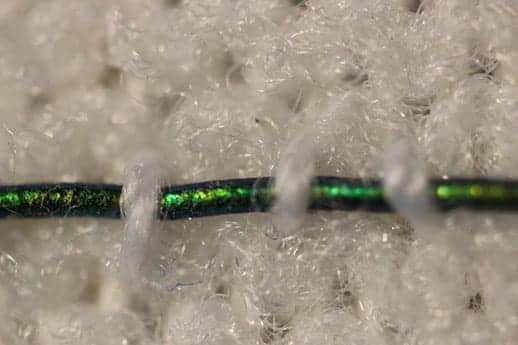
Pressure-sensing photonic fibers such as these, woven into a typical compression bandage, are designed to change color as the bandage stretches to match a desired pressure. (Photo courtesy of Massachusetts Institute of Technology)
Engineers from Massachusetts Institute of Technology have developed a compression bandage woven with pressure-sensitive photonic fibers designed to change color as the bandage stretches to match a desired pressure.
The photonic fibers can then serve as a continuous pressure sensor, according to the MIT team. If their color changes, caregivers or patients can use the color chart to determine whether and to what degree the bandage needs loosening or tightening.
“Getting the pressure right is critical in treating many medical conditions including venous ulcers, which affect several hundred thousand patients in the US each year,” says Mathias Kolle, assistant professor of mechanical engineering at MIT. “These fibers can provide information about the pressure that the bandage exerts. We can design them so that for a specific desired pressure, the fibers reflect an easily distinguished color.”
Results from the study of the material have been published in the journal Advanced Healthcare Materials.
Kolle and his team fabricated each fiber, which is about 10 times the diameter of a human hair, from ultrathin layers of transparent rubber materials, which they rolled up to create a jelly-roll-type structure. Each layer within the roll is only a few hundred nanometers thick. The fibers’ design relies upon an optical phenomenon known as “interference,” in which light, reflected from a periodic stack of thin, transparent layers, can produce vibrant colors that depend on the stack’s geometric parameters and material composition, explains a media release from Massachusetts Institute of Technology.
The team fabricated color-changing fibers with a tailored, strain-dependent color variation using the theoretical model, and then stitched them along the length of a conventional compression bandage, which they previously characterized to determine the pressure that the bandage generates when it’s stretched by a certain amount.
The team used the relationship between bandage stretch and pressure, and the correlation between fiber color and strain, to draw up a color chart, matching a fiber’s color (produced by a certain amount of stretching) to the pressure that is generated by the bandage.
To test the bandage’s effectiveness, the researchers enlisted over a dozen student volunteers, who worked in pairs to apply three different compression bandages to each other’s legs: a plain bandage, a bandage threaded with photonic fibers, and a commercially available bandage printed with rectangular patterns. This bandage is designed so that when it is applying an optimal pressure, users should see that the rectangles become squares.
Overall, the bandage woven with photonic fibers gave the clearest pressure feedback. Students were able to interpret the color of the fibers, and based on the color chart, apply a corresponding optimal pressure more accurately than either of the other bandages, the release continues.
The researchers are now looking for ways to scale up the fiber fabrication process. Currently, they are able to make fibers that are several inches long. Ideally, they would like to produce meters or even kilometers of such fibers at a time, to be threaded into bandages or textiles such as athletic apparel and shoes as color indicators for, say, muscle strain during workouts.
[Source(s): Massachusetts Institute of Technology, EurekAlert]




